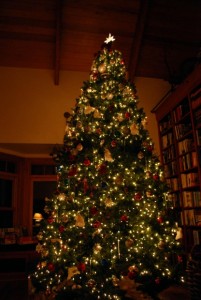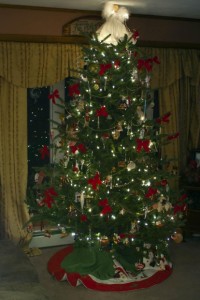Real Christmas Trees vs Artificial Trees
 ‘Tis the season when people often find themselves facing a dilemma: real Christmas trees vs artificial trees.
‘Tis the season when people often find themselves facing a dilemma: real Christmas trees vs artificial trees.
For some people, only a real tree will do, with its cheery evergreen scent. For others, an artificial tree presents a much-needed reprieve from mess. Both have pros and cons.
Artificial Trees
Artificial trees are growing in popularity due to their convenience. They offer a quick and easy way to trim the most familiar of Christmas decorations. Flexible branches allow for perfect ornament placement. There is no struggle trying fit the tree under a roof and into a standard only to have it fall down five minutes later, breaking multiple ornaments in the process. They never have to be watered. In the long run, they are more dollar efficient, as the same tree can be reused year after year, where a real tree must be purchased each year.
There are however many drawbacks to artificial trees. For one, they can be a source of lead poisoning. The dust from these trees is often full of lead dust. The materials used to make fake trees is non renewable, and non-biodegradable. Many people throw out their artificial trees after just a few years. In the case of the pre-lit sort, people often junk their trees as soon as the lights stop working. All these trees go into landfills. If they are burned, they send harmful gasses into the air. Most artificial trees are made overseas and the energy cost to create them, then transport them to the stores to be purchased, is several times that of a real tree.
Real Trees
Real trees are still the traditional choice for many. Selecting the perfect tree is often a family tradition. Being natural, real trees are fully biodegradable, and can be recycled after Christmas. They do not contain hazardous materials such as lead. As Christmas trees are a business, new trees are replanted for every tree that is cut. The purchase of real trees supports homegrown products as opposed to imports. And of course, they have that wonderful Christmas tree smell.
Even real trees have their drawbacks, however. For starters, real trees are cut down, not all of which are purchased. The leftovers just end up as mulch. Real trees are much messier, leaving a trail of needles in their wake, and they have a tendency to topple. If you plan to purchase one from a store instead of a U-cut lot, they can cost up to $100, and energy is expended to transport them to the store as well. Tree lots consume large amounts of water. Many use pesticides and fertilizers, and create a monoculture with harmful environmental impacts.
So how to minimize the harmful effects of either type of tree? In the case of artificial trees, first and foremost do not throw the tree away after just a few years. If you are going to get a fake tree, be in it for the long haul to help mitigate the effects of the energy used to produce it. Look for artificial trees made in your own country instead of overseas. If it’s a pre-lit tree, just run a new string of lights around it when the original lights go out instead of throwing it out and purchasing a new one. With reasonable care, your artificial tree can last you most of your life, cutting back on the environmental impact. In my own family, we have an artificial tree, due to the fact that our wood stove kept drying out real trees. We inherited one that’s over forty years old and we still put it up every year.
For real trees, a U-cut lot is the best bet, it’s far more affordable than purchasing a precut tree. Also, after the season, don’t just burn the tree, have it ground into mulch and use it to help new plants grow. While it does take energy to run the chipper, it produces less carbon dioxide than burning the tree would, and your garden will greatly thank you.
Living Trees
Perhaps the best Christmas tree a person can have is a living tree from a nursery. These trees come with a root ball, and continue to live even after the holiday season is over. There is no tree killing involved, and there is no worry about disposing of them afterward. They can be planted outdoors for a great environmental impact. If a full size living tree is too large, try a tabletop tree. While it does expend energy to transport the tree to a nursery and one’s home, that energy cost will be offset when the tree is later planted outdoors. A single tree, on average, can sponge up 60 pounds of carbon dioxide a year, and thus reduce the greenhouse effect. It also produces 120 pounds of oxygen a year. Good for the earth, good for us.
Copyright © Amber Reifsteck ~ The Woodland Elf
The information provided on this website is for general information purposes only. If you choose to rely on the information on this website, you do so at your own risk and you assume responsibility for the results. (Full disclaimer here)
Enjoy this post? Click here to subscribe by email and get new posts delivered to your inbox.Ads by Google









I’ve been using a fake tree for years now, with no intention of throwing it out. I love the way the branches bend at the tips to support the heavier decorations, and even though it loses a few needles each year, it still looks thick and bushy. This year is the 20th time I’ve put it up. It holds wonderful memories of Christmases past and as always, my favorite part of decorating it is adding the paper angel my daughter made in first grade to the top tier One thing it doesn’t have, though, is that lovely fresh scent. Hard to get everything perfect, isn’t it?
One thing it doesn’t have, though, is that lovely fresh scent. Hard to get everything perfect, isn’t it?
Ditto, love the way they bend and support heavy ornaments, definitely an advantage over real trees there. We cheat for the smell. We cut a few boughs of white pine and stick them in a vase near the tree = real tree smell, no real tree mess.
People don’t believe it when we tell them our tree is fake